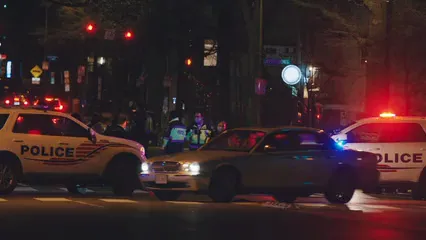Introduction
Crime statistics play a vital role in understanding the safety of a community. For residents and potential movers in Silver Spring, MD, these numbers matter. Not only do they reveal the risk of becoming a victim, but they also shape the overall perception of safety in the area.
Recent trends indicate that crime rates in Silver Spring have been a topic of concern. According to data from 2022, released by local law enforcement and the FBI in 2023, the crime landscape in Silver Spring shows a mix of challenges and improvements. Despite some positive trends, the city remains a hotspot for both violent and property crimes.
This article aims to provide a thorough overview of crime statistics in Silver Spring. It will compare local data to state and national averages, shedding light on the safety dynamics within the community. By understanding these statistics, residents can make informed decisions about their safety and future in Silver Spring.

Understanding Crime Statistics
What are Crime Statistics?
Crime statistics are numerical data that reflect the occurrence of criminal activities within a specific area. These numbers are crucial for public safety as they help identify trends, allocate resources, and inform community members about the risks they face.
Crime is typically categorized into two main types: violent crimes and property crimes. Violent crimes include offenses like murder, rape, robbery, and assault. These crimes directly harm individuals. On the other hand, property crimes involve theft or damage to property, such as burglary, larceny, and motor vehicle theft.
To measure crime, law enforcement agencies report incidents to databases like the FBI’s Uniform Crime Reporting (UCR) system. This information is compiled annually, providing a snapshot of crime trends over time. Understanding these statistics is essential for residents, law enforcement, and policymakers to work together towards a safer Silver Spring.

Sources of Crime Data
Understanding crime statistics in Silver Spring, MD, relies on various data sources. The FBI’s Uniform Crime Reporting (UCR) program is one of the primary national sources. It collects data from over 18,000 law enforcement agencies across the United States. This program provides a broad overview of crime trends, offering valuable insights into both violent and property crimes.
However, Silver Spring faces a unique challenge. It does not have specific FBI statistics available. This absence means that residents and researchers must lean heavily on local law enforcement reports for crime data. These local records can offer a more detailed picture of crime in the area, but they also have limitations. For instance, local data may not always reflect broader national trends or provide complete context.
Local law enforcement agencies, such as the Montgomery County Police Department, regularly publish crime reports. These reports include information on incidents, arrests, and ongoing investigations. They often break down statistics by type of crime, helping residents understand the safety landscape in their community.
Despite these efforts, local data can sometimes paint an incomplete picture. Variations in reporting practices between jurisdictions can lead to discrepancies. For instance, one department might classify incidents differently than another, making comparisons tricky. Additionally, the reliance on local statistics means that certain types of crimes may be underreported, especially those that do not come to the attention of law enforcement.
Ultimately, while local law enforcement data is invaluable, the lack of comprehensive FBI statistics for Silver Spring means that residents should use these resources with caution. Understanding the limitations of these data sources is crucial for making informed decisions about safety in the area.

Overview of Crime Rates in Silver Spring, MD
Current Crime Rates
Silver Spring, MD, has a crime rate of 36 incidents per 1,000 residents. This figure places it among the higher crime rates in the nation. Comparatively, the national average hovers around 22 incidents per 1,000 residents. This stark difference emphasizes the safety challenges faced by Silver Spring residents.
When we take a closer look at Maryland’s overall crime rate, the state averages about 25 incidents per 1,000 residents. Thus, Silver Spring’s crime rate significantly exceeds both state and national averages, raising concerns about safety in the community. For a deeper understanding of crime statistics in Maryland, you can refer to the Camden crime statistics.
Understanding the crime rates in Maryland, particularly in Camden, can provide a broader context for the safety dynamics in Silver Spring. Explore Camden crime statistics for more insights.

Violent Crimes
Violent crime rates in Silver Spring paint a concerning picture. The latest statistics indicate a violent crime rate of 4.14 per 1,000 residents. In comparison, the national average for violent crimes is approximately 4 incidents per 1,000 residents. This means that Silver Spring’s violent crime rate aligns closely with the national figure, but it still presents a risk to residents.
Breaking it down further, the city reported a total of 335 violent crimes. This category includes serious offenses such as murder, rape, robbery, and assault. Specifically, the chances of becoming a victim of violent crime in Silver Spring are about 1 in 242, indicating a significant risk for residents.

Property Crimes
Property crimes represent a major concern in Silver Spring. The area has a staggering property crime rate of 32.19 incidents per 1,000 residents. This is more than double the national average of 20 incidents per 1,000 residents.
In total, Silver Spring reported 2,608 property crimes. This includes various offenses, such as burglary, larceny, and motor vehicle theft. Notably, motor vehicle theft rates have reached alarming levels, with residents facing a 1 in 234 chance of experiencing this crime. Such high rates reveal an urgent need for enhanced safety measures and community engagement in crime prevention strategies.

To bolster your home security, consider investing in a Home Security Camera System. With the ability to monitor your property remotely, you can keep an eye on your home and receive alerts about any suspicious activity. This peace of mind is invaluable, especially in neighborhoods with higher crime rates.
In summary, crime statistics for Silver Spring showcase a combination of higher-than-average rates for both violent and property crimes. Understanding these figures is essential for residents, local authorities, and potential movers. By being informed, the community can take proactive steps toward improving safety and reducing crime in Silver Spring.

Comparative Analysis with State and National Averages
To understand how Silver Spring, MD, stacks up against broader trends, here’s a handy table showing crime rates per 1,000 residents. This comparison includes data from Maryland and the national median.
| Type of Crime | Silver Spring | Maryland (State) | National Median |
|---|---|---|---|
| Violent Crime | 4.14 | 3.98 | 4 |
| Property Crime | 32.19 | 16.35 | 20 |

As you can see, Silver Spring’s violent crime rate is slightly above the national average. However, the property crime rate is significantly higher, more than 60% above the state average. This discrepancy can stir a cocktail of emotions among residents—from concern to a desire for community action.
Such comparisons can affect public perception. When crime rates are high, residents might feel less secure, prompting them to take precautions. This could include neighborhood watch programs or increased engagement with local law enforcement. Conversely, lower crime rates often lead to feelings of safety and community trust.
Understanding these statistics helps residents gauge their safety levels. It also emphasizes the need for continued community involvement and proactive measures to enhance safety.

Crime Trends Over Time
Historical Data Overview
Over the past few years, Silver Spring has seen fluctuating crime trends. In 2022, the area reported a notable increase in property crimes, particularly motor vehicle thefts, which have hit an all-time high. This has raised eyebrows and sparked discussions about community safety.
However, not all news is grim. Law enforcement initiatives and community programs aimed at crime reduction have shown positive outcomes. For instance, targeted policing efforts in high-crime areas have led to a decrease in certain violent crimes, offering a glimmer of hope amidst the numbers.

Factors Influencing Crime Rates
Several factors contribute to the crime landscape in Silver Spring. Social dynamics play a crucial role. The area’s population density creates a vibrant community but can also lead to increased opportunities for crime. Economic conditions, such as unemployment rates and local economic health, directly influence crime rates—higher unemployment often correlates with rising crime.
Additionally, community engagement is vital. Areas with active neighborhood watch programs or community events tend to have lower crime rates. When residents collaborate, they create a more vigilant environment. This community spirit is crucial for fostering safety and trust among neighbors.
For those looking to enhance their personal safety, investing in a Personal Safety Alarm can provide peace of mind. These compact devices emit a loud sound when activated, drawing attention in case of an emergency and potentially deterring any threats.
In summary, understanding these trends and factors allows residents and local authorities to work together. Collective efforts can help to reduce crime rates and enhance safety in Silver Spring.

Neighborhood Safety Insights
Safe and Unsafe Areas
Silver Spring, MD, is a vibrant area filled with diverse neighborhoods. However, crime rates vary significantly from one neighborhood to the next. Among the safest neighborhoods is Woodside Park, where community engagement and active neighborhood watch programs contribute to a low crime rate. Residents report feeling secure and appreciate the visible presence of law enforcement.
In stark contrast, areas like Downtown Silver Spring and parts of Northwood Park have garnered attention for higher crime rates. According to local reports, Downtown Silver Spring accounts for about 9% of all county crimes, with a notable increase in motor vehicle thefts, raising concerns among residents. Feedback from community safety surveys indicates that many residents in these neighborhoods feel uneasy, particularly during the late evening hours.
While Northwood Park is also known for its community spirit, its proximity to busier areas has led to an uptick in property crimes, such as burglaries and theft. An informal poll revealed that nearly 60% of residents expressed concerns about safety, specifically regarding their vehicles. In contrast, neighborhoods like Kemp Mill Estates and Fairknoll boast lower crime rates, with residents feeling more confident in their surroundings.

Community Initiatives
Silver Spring is not sitting idly while crime rates raise eyebrows. Local authorities and community organizations are actively working to improve safety. One notable initiative is the Montgomery County Police Department’s “Safe Streets” program. This initiative focuses on collaboration between law enforcement and community members to address specific crime issues, especially in neighborhoods facing higher rates of property crime.
The program has implemented successful strategies, such as increased patrols in high-crime areas and community workshops on crime prevention. These workshops empower residents with knowledge on how to secure their homes and vehicles. Feedback from participants has been overwhelmingly positive, with many reporting a newfound sense of security.
Another impactful effort comes from neighborhood watch groups that have sprung up in various communities. These groups foster unity and communication among residents, helping to deter crime through vigilance. In areas where these groups are active, crime rates have shown a noticeable decline. For instance, the Northwood Park neighborhood has seen a reduction in property crimes since the establishment of its watch group.
Moreover, the police department’s community engagement initiatives, such as open forums and safety fairs, have strengthened relationships with residents. This collaboration has led to increased reporting of suspicious activities and a greater sense of community pride. Local law enforcement has also embraced technology, utilizing social media platforms to share safety tips and updates, fostering a culture of transparency and trust.
In summary, Silver Spring’s community initiatives reflect a commitment to improving safety and reducing crime. By actively engaging residents and fostering collaboration between law enforcement and the community, these programs are making a tangible difference in crime statistics. As residents become more involved, the potential for safer neighborhoods grows, leading to a more secure and vibrant Silver Spring.

Conclusion
Understanding crime statistics in Silver Spring, MD, reveals a complex landscape of safety concerns and community efforts. The disparities in crime rates across neighborhoods highlight the need for targeted initiatives to address specific challenges. Residents in safer areas can enjoy peace of mind, while those in higher-crime neighborhoods seek urgent improvements.
The positive trends resulting from community initiatives and law enforcement collaboration are encouraging. Programs like “Safe Streets” and active neighborhood watch groups demonstrate how collective efforts can lead to reduced crime rates and enhanced safety. Engaged communities are vital in creating a vigilant environment, fostering trust between residents and law enforcement.
As Silver Spring moves forward, continued community involvement will be crucial in addressing crime and enhancing safety. Residents must stay informed and participate in local initiatives, ensuring their voices are heard. Together, they can work towards a safer, more secure Silver Spring for everyone.

FAQs
What is the overall crime rate in Silver Spring, MD?
Silver Spring, MD, has a high crime rate of 36 incidents per 1,000 residents. This figure is significantly above the national average of 22 incidents per 1,000 residents. The likelihood of becoming a victim of either violent or property crime is roughly 1 in 28, indicating a pressing need for community awareness and safety initiatives.
How does Silver Spring compare to other cities in Maryland?
When compared to other cities in Maryland, Silver Spring’s crime rate stands out. The state’s average crime rate is about 25 incidents per 1,000 residents. This means Silver Spring’s crime rate is markedly higher, contributing to a perception of reduced safety. The differences in statistics can lead to varied responses from the community, emphasizing the importance of safety initiatives.
What can residents do to improve safety in their neighborhood?
Residents can take proactive steps to enhance neighborhood safety. Forming neighborhood watch groups can foster community vigilance. Participating in local safety workshops helps raise awareness about crime prevention. Engaging with local law enforcement through community meetings can also strengthen relationships and encourage reporting of suspicious activities. Finally, utilizing crime mapping tools can help residents stay informed about local incidents.
Where can I find more detailed crime data for Silver Spring?
For a deeper dive into crime data, residents can visit local law enforcement websites, such as the Montgomery County Police Department’s site. Platforms like NeighborhoodScout and AreaVibes offer comprehensive crime reports and statistics. Additionally, the dataMontgomery website provides interactive crime maps and datasets that can help residents stay informed and engaged.
Is Silver Spring safe for families?
Safety perceptions for families in Silver Spring vary. Based on community feedback, many residents feel relatively safe, with 51% stating they are “pretty safe.” However, the relatively high crime rates, especially for property crimes, can raise concerns. Families are encouraged to participate in community safety programs to foster a more secure environment. Engaging with local law enforcement can also enhance feelings of safety and provide valuable resources.
To enhance your home security further, consider adding a Smart Door Lock. This high-tech gadget allows you to control access to your home remotely, providing an added layer of security that can deter potential intruders.
Please let us know what you think about our content by leaving a comment down below!
Thank you for reading till here 🙂
All images from Pexels




